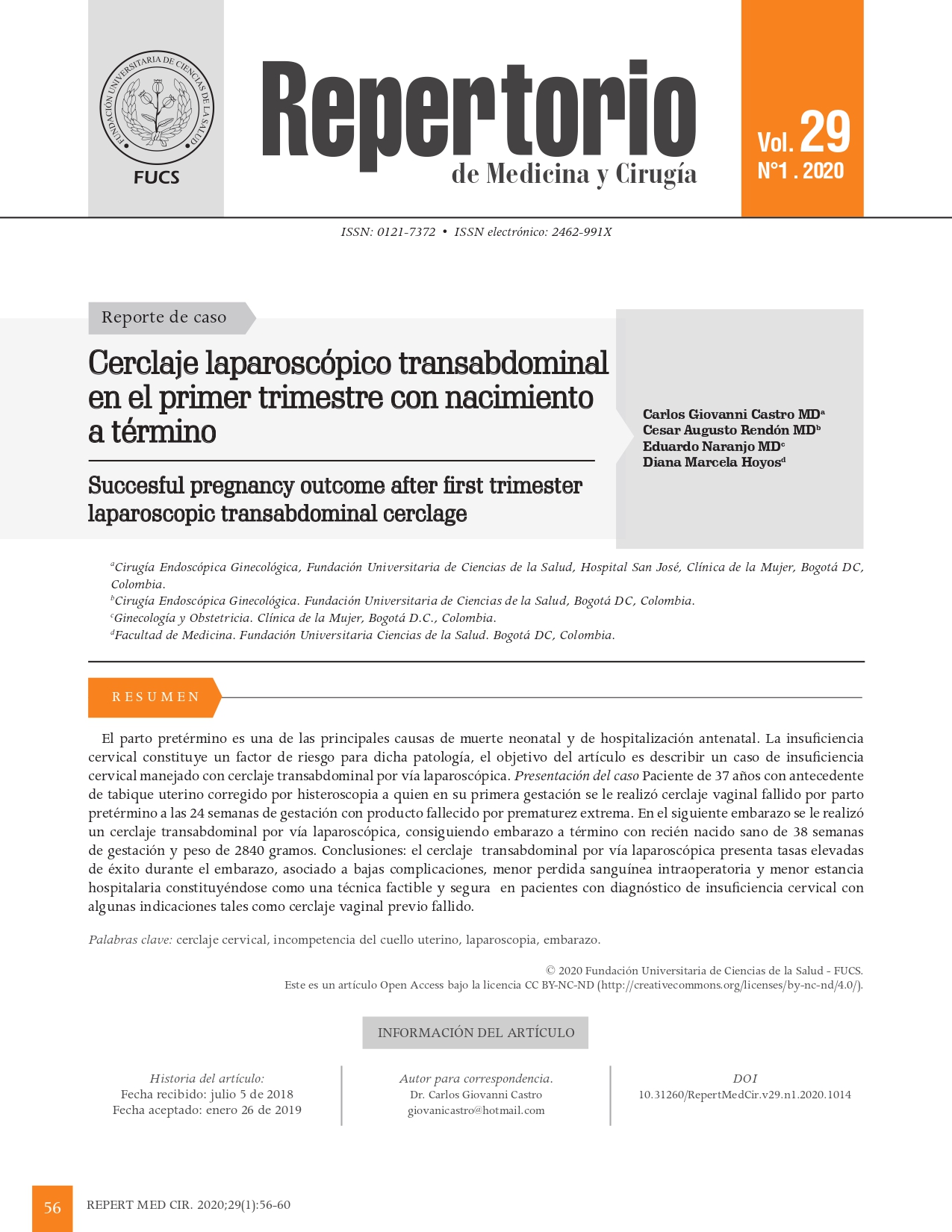Cerclaje transabdominal con abordaje laparoscópico en el primer trimestre con nacimiento a término
Successful term delivery case of laparoscopic transabdominal cerclage performed at first trimester of gestation
Cómo citar
Descargar cita
Esta obra está bajo una licencia internacional Creative Commons Atribución-NoComercial-CompartirIgual 4.0.
Mostrar biografía de los autores
El parto pretérmino es una de las principales causas de muerte neonatal y de hospitalización antenatal. La insuficiencia cervical constituye un factor de riesgo para dicha patología, el objetivo del artículo es describir un caso de insuficiencia cervical manejado con cerclaje transabdominal por vía laparoscópica. Presentación del caso Paciente de 37 años con antecedente de tabique uterino corregido por histeroscopia a quien en su primera gestación se le realizó cerclaje vaginal fallido por parto pretérmino a las 24 semanas de gestación con producto fallecido por prematurez extrema. En el siguiente embarazo se le realizó un cerclaje transabdominal por vía laparoscópica, consiguiendo embarazo a término con recién nacido sano de 38 semanas de gestación y peso de 2840 gramos. Conclusiones: el cerclaje transabdominal por vía laparoscópica presenta tasas elevadas de éxito durante el embarazo, asociado a bajas complicaciones, menor perdida sanguínea intraoperatoria y menor estancia hospitalaria constituyéndose como una técnica factible y segura en pacientes con diagnóstico de insuficiencia cervical con algunas indicaciones tales como cerclaje vaginal previo fallido.
Visitas del artículo 921 | Visitas PDF 950
Descargas
- Practice Bulletin No. 159 Summary: Management of Preterm Labor. Obstet Gynecol.2016; 127(1):190-1, doi:10.1097/AOG.0000000000001260.
- Goldenberg RL, Culhane JF, Iams JD, Romero R. Epidemiology and causes of preterm birth. Lancet Lond Engl.2008; 371(9606):75-84, doi: 10.1016/S0140-6736(08)60074-4.
- Blencowe H, Cousens S, Oestergaard MZ, Chou D, Moller A-B, Narwal R, et al. National, regional, and worldwide estimates of preterm birth rates in the year 2010 with time trends since 1990 for selected countries: a systematic analysis and implications. Lancet Lond Engl.2012; 379(9832):2162-72, doi: 10.1016/S0140-6736(12)60820-4.
- OMS | Informe de Acción Global sobre Nacimientos Prematuros [Internet]. WHO. [Visitado el 24 de abril de 2017]. Disponible en: http://www.who.int/pmnch/media/news/2012/preterm_birth_report/es/
- Koullali B, Oudijk MA, Nijman T a. J, Mol BWJ, Pajkrt E. Risk assessment and management to prevent preterm birth. Semin Fetal Neonatal Med.2016; 21(2):80-8, doi:10.1016/j.siny.2016.01.005.
- American College of Obstetricians and Gynecologists. ACOG Practice Bulletin No.142: Cerclage for the management of cervical insufficiency. Obstet Gynecol.2014; 123(2 Pt 1):372-9, doi:10.1097/01.AOG.0000443276.68274.cc.
- Brown R, Gagnon R, Delisle M-F, MATERNAL FETAL MEDICINE COMMITTEE. Cervical insufficiency and cervical cerclage. J Obstet Gynaecol Can JOGC J Obstet Gynecol Can JOGC. 2013; 35(12):1115-27.
- Sperling JD, Dahlke JD, Gonzalez JM. Cerclage Use: A Review of 3 National Guidelines. Obstet Gynecol Surv.2017; 72(4):235-41.
- Shiber L-D, Lang T, Pasic R. First Trimester Laparoscopic Cerclage. J Minim Invasive Gynecol. 2015; 22(5):715-6, doi:10.1016/j.jmig.2015.03.007.
- Besio R M, Besio H C. CERCLAJE CÉRVICO-ÍSTMICO TRANSABDOMINAL: SERIE CLÍNICA. Rev Chil Obstet Ginecol. 2004; 69(2):126-31.
- Ades A, May J, Cade TJ, Umstad MP. Laparoscopic transabdominal cervical cerclage: a 6-year experience. Aust N Z J Obstet Gynaecol.2014; 54(2):117-20, doi:10.1111/ajo.12156.
- Ades A, Dobromilsky KC, Cheung KT, Umstad MP. Transabdominal Cervical Cerclage: Laparoscopy Versus Laparotomy. J Minim Invasive Gynecol.2015; 22(6):968-73, doi:10.1016/j.jmig.2015.04.019.
- Burger NB, Brölmann H a. M, Einarsson JI, Langebrekke A, Huirne J a. F. Effectiveness of abdominal cerclage placed via laparotomy or laparoscopy: systematic review. J Minim Invasive Gynecol.2011; 18(6):696-704, doi:10.1016/j.jmig.2011.07.009.
- Ghomi A, Rodgers B. Laparoscopic abdominal cerclage during pregnancy: A case report and a review of the described operative techniques. J Minim Invasive Gynecol.2006; 13(4):337-41, doi:10.1016/j.jmig.2006.04.002.
- Bolla D, Raio L, Imboden S, Mueller MD. Laparoscopic Cerclage as a Treatment Option for Cervical Insufficiency. Geburtshilfe Frauenheilkd.2015; 75(8):833-8, doi:10.1055/s-0035-1557762.
- Benson RC, Durfee RB. TRANSABDOMINAL CERVICO UTERINE CERCLAGE DURING PREGNANCY FOR THE TREATMENT OF CERVICAL INCOMPETENCY. Obstet Gynecol.1965; 25:145-55.
- Davis G, Berghella V, Talucci M, Wapner RJ. Patients with a prior failed transvaginal cerclage: a comparison of obstetric outcomes with either transabdominal or transvaginal cerclage. Am J Obstet Gynecol.2000; 183(4):836-9, doi: 10.1067/mob.2000.108837
- Burger NB, Einarsson JI, Brölmann HAM, Vree FEM, McElrath TF, Huirne JAF. Preconceptional laparoscopic abdominal cerclage: a multicenter cohort study. Am J Obstet Gynecol.2012; 207(4):273.e1-12, doi:10.1155/2014/519826.
- Huang X, Ma N, Li T-C, Guo Y, Song D, Zhao Y, et al. Simplified laparoscopic cervical cerclage after failure of vaginal suture: technique and results of a consecutive series of 100 cases. Eur J Obstet Gynecol Reprod Biol. 2016; 201:146-50.
- Resnik, R, Robert, C, Lams, J, Lockwood CJ, Moore T, Greene MF. Creasy and Resnik’s Maternal-Fetal Medicine: Principles and Practice. 7 ed. Elsevier; 2013.
- Fuchs F, Deffieux X, Senat M-V, Gervaise A, Faivre E, Frydman R, et al. Techniques chirurgicales de cerclage du col utérin EMC. Elsevier; 2000. p. 7. doi: 10.1016/S0000-0000(10)52958-9.













